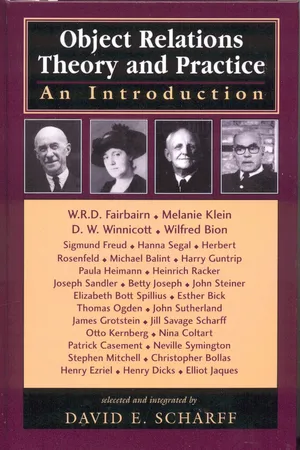
- English
- ePUB (mobile friendly)
- Available on iOS & Android
eBook - ePub
About this book
Object relations theory has caused a fundamental reorientation of psychodynamic thought. In Object Relations Theory and Practice, Dr. David E. Scharff acclimates readers to the language and culture of this therapeutic perspective and provides carefully selected excerpts from seminal theorists as well as explanations of their thinking and clinical experience. He offers readers an unparalleled resource for understanding object relations psychotherapy and theory and applying it to the practice of psychotherapy and psychoanalysis. The book's sequence establishes the centrality of relationships in this theory: the internalization of experience with parents, splitting, projective identification, the role of the relationship between mother and young child in development, and transference and countertransference in the therapeutic action of psychoanalysis and psychotherapy. This book will introduce students to the basics, to the widening scope of object relations theory, and to its application to psychoanalysis and individual, group, and family psychotherapy.
Frequently asked questions
Yes, you can cancel anytime from the Subscription tab in your account settings on the Perlego website. Your subscription will stay active until the end of your current billing period. Learn how to cancel your subscription.
At the moment all of our mobile-responsive ePub books are available to download via the app. Most of our PDFs are also available to download and we're working on making the final remaining ones downloadable now. Learn more here.
Perlego offers two plans: Essential and Complete
- Essential is ideal for learners and professionals who enjoy exploring a wide range of subjects. Access the Essential Library with 800,000+ trusted titles and best-sellers across business, personal growth, and the humanities. Includes unlimited reading time and Standard Read Aloud voice.
- Complete: Perfect for advanced learners and researchers needing full, unrestricted access. Unlock 1.4M+ books across hundreds of subjects, including academic and specialized titles. The Complete Plan also includes advanced features like Premium Read Aloud and Research Assistant.
We are an online textbook subscription service, where you can get access to an entire online library for less than the price of a single book per month. With over 1 million books across 1000+ topics, we’ve got you covered! Learn more here.
Look out for the read-aloud symbol on your next book to see if you can listen to it. The read-aloud tool reads text aloud for you, highlighting the text as it is being read. You can pause it, speed it up and slow it down. Learn more here.
Yes! You can use the Perlego app on both iOS or Android devices to read anytime, anywhere — even offline. Perfect for commutes or when you’re on the go.
Please note we cannot support devices running on iOS 13 and Android 7 or earlier. Learn more about using the app.
Please note we cannot support devices running on iOS 13 and Android 7 or earlier. Learn more about using the app.
Yes, you can access Object Relations Theory and Practice by David E. Scharff in PDF and/or ePUB format, as well as other popular books in Psychology & Cognitive Psychology & Cognition. We have over one million books available in our catalogue for you to explore.
Information
Table of contents
- Cover
- Half title
- Title
- Copyright
- Abouttheeditor
- Dedication
- Contents
- Preface and Acknowledgments
- Part I The Origins of Object Relations Theory
- Part II Sigmund Freud
- Part III W. R. D. Fairbairn
- Part IV Melanie Klein
- Part V D. W. Winnicott
- Part VI Wilfred Bion
- Part VII Klein’s Theory Elaborated
- Part VIII Early Contributions of the Independent Group
- Part IX Transference and Countertransference
- Part X Advances in Theory
- Part XI Advances in Clinical Concepts
- Part XII Treating Groups, Families, and Institutions
- Part XIII Suggestions for Further Reading
- Credits
- Index